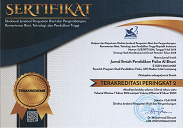Ufer grounding system to minimize risk of lightning strike using concrete mixed with bentonite and coconut fiber
Abstract
Keywords
Full Text:
PDFReferences
Al-Ammar, E., Khan, Y., Malik, N., & Wani, N. (2010). Development of low resistivity material for grounding resistance reduction. IEEE International Energy Conference Efwfmpqnfou, 35(1), 700–703.
Borgesson, L. (1985). Water flow and swelling pressure in non-saturated Bentonite-Based Clay Barriers. Engineering Geology, 21(3–4), 229–237.
Fink, D. G., & Beaty, H. W. (2006). Standard Handbook for Electrical Engineers. (15th ed.). New York City: McGraw-Hill.
Ghania, S. M. (2019). Grounding systems under lightning surges with soil ionization for high voltage substations by using two layer capacitors (TLC) model. Electric Power Systems Research, 174(1), 1–12. https://doi.org/10.1016/j.epsr.2019.105871
Gomes, C., Ab Kadir, M. Z. A., Kottachchi, C. L., & Lim, S. C. (2014). Industrial wastes and natural substances for improving electrical earthing systems. International Journal of Electrical Engineering, 21(2), 39–47. https://doi.org/10.6329/CIEE.2014.2.01
Halim, N. H., Hairuddin, M. F., Arshad, S. N. M., Isa, M., Adzis, Z., & Khang, A. W. Y. (2019). Analysis on topology of grounding system using bentonite and coconut husk as additive material. Universal Journal of Electrical and Electronic Engineering, 6(5), 50–58. https://doi.org/10.13189/ujeee.2019.061506
Jin-rong, W., & Yong-ming, D. (2008). The Application of Conductive Concrete in the Grounding Network Reconstruction of Baisha Hydropower Station. CNKI.
Kusrini, N. (2018). Pemanfaatan bentonit, kapur dan limbah puing bangunan untuk meningkatkan kapasitas tanah tropika dalam menurunkan resistansi grounding. Universitas Lampung.
Lehmann, J., Coumou, D., & Frieler, K. (2015). Erratum to: increased record-breaking precipitation events under global warming. Climatic Change, 132(4), 517–518. https://doi.org/10.1007/s10584-015-1466-3
Lim, S. C., Gomes, C., & Kadir, M. Z. A. A. (2016). Behaviour of a new material that improves Ufer grounding practice. J. Electrial Systems, 12(2), 291–300.
Lim, S. C., Gomes, C., & Ab Kadir, M. Z. A. (2013). Characterizing of bentonite with chemical, physical and electrical perspectives for improvement of electrical grounding systems. International Journal of Electrochemical Science, 8(9), 11429–11447.
Ma, H., Hou, D., Liu, J., & Li, Z. (2014). Estimate the relative electrical conductivity of C-S-H gel from experimental results. Construction and Building Materials, 71(1), 392–396. https://doi.org/10.1016/j.conbuildmat.2014.08.036
Martin, Y., Permata, D., Despa, D., & Wiyoto, Y. L. (2019). The use of physically activated and soil composed bentonite as environment friendly for grounding resistance. IOP Conference Series: Earth and Environmental Science, 245(1). https://doi.org/10.1088/1755-1315/245/1/012004
Martin, Y. (2019). Composition of mixing gypsum additives as environmentally friendly material in tropical soil to reduce grounding resistance. IOP Conference Series: Earth and Environmental Science, 314(1), 1–8. https://doi.org/10.1088/1755-1315/314/1/012019
Nasional, Badan Standardisasi. (2002). Tata Cara Pencampuran Beton Ringan Dengan Agregat Ringan. Jakarta: Departemen Pekerjaan Umum.
Nasional, Badan Standardisasi. (2008). Cara Uji Berat Jenis dan Penyerapan Air Agregat Halus. Jakarta: Departemen Pekerjaan Umum.
Nasional, Badan Standarisasi. (2004). Semen Portland Komposit. Jakarta: Departemen Pekerjaan Umum.
Naswir, M., Gusti Wibowo, Y., Arita, S., Hartati, W., & Septiarini, L. (2019). Utilization of activated bentonite to reduce nitrogen on palm oil mill. International Journal of Chemical Sciences, 3(4), 89–92. https://www.researchgate.net/publication/335738640
Ogunbode, C. A., Demski, C., Capstick, S. B., & Sposato, R. G. (2019). Attribution matters: Revisiting the link between extreme weather experience and climate change mitigation responses. Global Environmental Change, 54(1), 31–39. https://doi.org/10.1016/j.gloenvcha.2018.11.005
Önal, M., & Sarikaya, Y. (2007). Preparation and characterization of acid-activated bentonite powders. Powder Technology, 172(1), 14–18. https://doi.org/10.1016/j.powtec.2006.10.034
Özcan, A. S., & Özcan, A. (2004). Adsorption of acid dyes from aqueous solutions onto acid-activated bentonite. Journal of Colloid and Interface Science, 276(1), 39–46. https://doi.org/10.1016/j.jcis.2004.03.043
Rahmat, A., & Mutolib, A. (2016). Comparison of air temperature under global climate change issue in Gifu City and Ogaki City, Japan. Indonesian Journal of Science and Technology, 1(1), 37–46. https://doi.org/10.17509/ijost.v1i1.2212
Ralph, E. G., & Guven, N. (1978). Bentonites: Geology, mineralogy, properties and uses (Developmen). Amsterdam: Elsevier Science.
Shen, Y. H. (2001). Preparations of organobentonite using nonionic surfactants. Chemosphere, 44(5), 989–995. https://doi.org/10.1016/S0045-6535(00)00564-6
Sun. (2001). Application of Conductive Concrete in Grounding Grid in Substation. High Voltage Engineering, 10(1).
Hutauruk, T. S. (1991). Pengetanahan netral sistem tenaga dan pengetanahan peralatan. Erlangga.
Tian, X., Hu, H., & Chen, B. (2012). An Environment-Friendly Conductive Concrete. Earth Science Research, 1(2), 185–188. https://doi.org/10.5539/esr.v1n2p185
Tjokrodimulyo, K. (2007). Teknologi Beton. Biro Penerbit Jurusan Teknik Sipil Fakultas Teknik Ugm.
Umum, D. P. (2010). Spesifikasi umum bidang jalan dan jembatan, badan penelitian dan pengembangan PU. Jakarta: Departemen Umum.
Villar, M. V., & Lloret, A. (2004). Influence of temperature on the hydro-mechanical behaviour of a compacted bentonite. Applied Clay Science, 26(1-4 SPEC. ISS.), 337–350. https://doi.org/10.1016/j.clay.2003.12.026
DOI: http://dx.doi.org/10.24042/jipfalbiruni.v9i1.6281
Refbacks
- There are currently no refbacks.

Jurnal ilmiah pendidikan fisika Al-Biruni is licensed under a Creative Commons Attribution-ShareAlike 4.0 International License.
![]()







